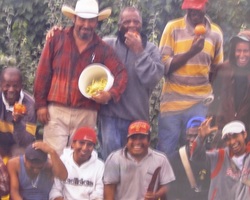Seasonal Workers: new models

"The necessity for seasonal labor in agriculture will long remain. Indeed, a mobile labor reserve is efficient and desirable."- from "Migratory Farm Labor in the United States," by Paul S. Taylor in Monthly Labor Review ,
U.S. Department of Labor (1937).
This paper, written almost 80 years ago, is a snapshot of seasonal labor at that time and a reminder of how little has changed since then relative to new technology and social policies. The author describes how mechanization had reduced the use of migrant labor for some crops but predicts, correctly, that it will not eliminate the need for seasonal labor for most fruit, berry and vegetable harvests. Given that, he states that the challenge for our society is to insure decent wages and housing, family support, health care and other benefits for those workers.
While improvements historically have come from negotiations by farmworker organizations, the impact of social services developed for the broader population, expansion of public education and other legal and policy changes, immigration reform itself offers a unique opportunity to re-think the system itself. And that could be sparked by the interests and priorities of the growing Latino population.
New data from the Department of Agriculture shows a 21 percent increase in Latino-operated farms over the past five years; most are small and mid-size farms. In interviews with some of those farmers in California, the New York Times reported that, "While more Hispanics are running farms, many of them in the region say federal immigration policies have made it increasingly difficult to find workers. ...Perhaps because of their own backgrounds, many of the farmers prided themselves on treating their workers well."
U.S. Department of Labor (1937).
This paper, written almost 80 years ago, is a snapshot of seasonal labor at that time and a reminder of how little has changed since then relative to new technology and social policies. The author describes how mechanization had reduced the use of migrant labor for some crops but predicts, correctly, that it will not eliminate the need for seasonal labor for most fruit, berry and vegetable harvests. Given that, he states that the challenge for our society is to insure decent wages and housing, family support, health care and other benefits for those workers.
While improvements historically have come from negotiations by farmworker organizations, the impact of social services developed for the broader population, expansion of public education and other legal and policy changes, immigration reform itself offers a unique opportunity to re-think the system itself. And that could be sparked by the interests and priorities of the growing Latino population.
New data from the Department of Agriculture shows a 21 percent increase in Latino-operated farms over the past five years; most are small and mid-size farms. In interviews with some of those farmers in California, the New York Times reported that, "While more Hispanics are running farms, many of them in the region say federal immigration policies have made it increasingly difficult to find workers. ...Perhaps because of their own backgrounds, many of the farmers prided themselves on treating their workers well."